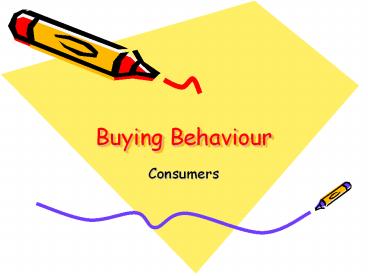Buying Behaviour - PowerPoint PPT Presentation
1 / 33
Title:
Buying Behaviour
Description:
buying behaviour consumers * * * 11 * * * * * * * * * * * * * social influences marketing influences situational influences psychological influences consumer decision ... – PowerPoint PPT presentation
Number of Views:119
Avg rating:3.0/5.0
Title: Buying Behaviour
1
Buying Behaviour
- Consumers
2
Overview of the Buying Process
SOCIAL INFLUENCES
MARKETING INFLUENCES
SITUATIONAL INFLUENCES
PSYCHOLOGICAL INFLUENCES
CONSUMER DECISION MAKING
3
Social Influences
- Culture and Subculture
- The family
- Religious Organizations
- Educational Institutions
4
Social Influences
- Social Class
- Rank of people in a society based on
- Wealth
- Skill
- Power
5
Social Influences
- Reference Groups
- A set of people a consumer wants to please or
imitate. - Family
- Fraternal or professional organizations
- Opinion leaders
6
Marketing Influences
- Product
- marketers differentiate their products to create
the perception of a valuable product purchase. - Price
- consumers may buy products more on the basis of
price than other attributes.
7
Marketing Influences
- Promotion
- marketing communications plays a critical role in
informing consumers about products and services. - Place
- Convenience increases the probability of
consumers finding and buying certain products.
8
Situational Influences
- Temporary forces associated with the immediate
buying environment that affect behaviour.
- Physical features
- Social features
- Time
- Task features
- Current conditions
9
Psychological Influences
- Product knowledge
- the amount of information a consumer has about
product classes, brands, models and ways to
purchase them. - Product involvement
- a consumers perception of the importance or
personal relevance of an item. - Perception
10
Decision Making Process
NEED RECOGNITION
ALTERNATIVE SEARCH
ALTERNATIVE EVALUATION
PURCHASE DECISION
POSTPURCHASE EVALUATION
11
Need Recognition
- Maslows Hierarchy of needs
- Recognition that you have an unsatisfied need.
- Marketers job to identify needs and provide
solutions.
12
Alternative Search
- Individual tries to identify ways to fulfill the
need. - Internal sources
- Group sources
- Marketing sources
- Public sources
- Experiential sources
13
Alternative Evaluation
- Consumer considers information gathered.
- Ranks features or attributes.
- Compares information to perception of need.
14
Purchase Decision
- If no other factors intervene, purchase is made.
- Purchaser may try to reduce risk or uncertainty.
15
Post-Purchase Evaluation
- Consumer evaluates the quality of the decision
made. - Does the product meet expectations.
- Post-purchase evaluation affects next purchase by
providing - Information about need satisfaction
- Information about product features quality
16
Business, Government and Institutional Buying
17
Organizational Buyers
- Producers
- Buy products to produce other products
- Intermediaries
- Buy products for resale
- Government Agencies
- Buy products for public programs
- Other Institutions
- Hospitals, museums, universities, churches
18
Overview of the Buying Process
PURCHASE TYPE INFLUENCES
STRUCTURAL INFLUENCES
BEHAVIOURAL INFLUENCES
ORGANIZATIONAL BUYING PROCESS
19
Purchase Type Influences
- New Task Purchase
- Most often used for big-ticket items,
- Happen occasionally,
- Are heavily researched and formal.
- Straight Rebuy
- Routine reordering from a supplier used in the
past. - Modified Rebuy
- When some aspects of the buying process are
unfamiliar.
20
Purchase Type Comparison
Complexity
Time Frame
of Suppliers
New Task Purchase
Complex
Long
Many
Straight Rebuy
Simple
Short
One
Modified Rebuy
Moderate
Medium
Few
21
Structural Influences
- Purchasing Roles
- Organization-Specific Factors
- Purchasing Policies and Procedures
22
Purchasing Roles
Users
Initiators
Gate-keepers
Buying Centre
Influencers
Buyers
Deciders
23
Organization-Specific Factors
- Orientation
- Dominant function may control purchasing
- Size
- Larger organizations may require more
coordination of the process - Degree of Centralization
- Influences level of joint decision-making
24
Behavioural Influences
- Personal Motivations
- Role Perceptions
25
Organizational Buying Process
ORGANIZATIONAL NEED
VENDOR ANALYSIS
PURCHASE DECISION
POSTPURCHASE EVALUATION
26
Organizational Need
- Non-emotional
- Best means to meet corporate goals
27
Vendor Analysis
- Seek and evaluate vendors
- To develop an approved vendor list
- To compare competing vendors
- To compare evaluation criteria and performance
28
(No Transcript)
29
Purchase Decision
- Must meet the organizations goals and procedures
- Eliminates the emotion of the consumer purchase
30
Post-Purchase Evaluation
- Comparison of product and vendor performance to
purchase criteria - Whose criteria?
- May lead to straight rebuy contract
31
Organizational Buying Distinctions
- More variation in buyer-seller relationships
- Shorter distribution channels
- Greater emphasis on personal selling
- Greater web integration
- Unique promotional strategies
32
The End
33
Maslows Hierarchy of Needs
SELF ACTUALIZATION
PERSONAL
SOCIAL NEEDS
SAFETY NEEDS
PHYSIOLOGICAL NEEDS































